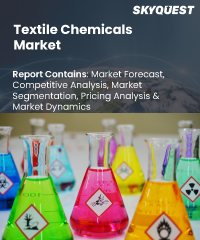
Report ID: SQMIG15E2153

Report ID:
SQMIG15E2153 |
Region:
Global |
Published Date: July, 2024
Pages:
184
|
Tables:
68 |
Figures:
75
Textile Chemicals Market size was valued at USD 26.19 Billion in 2023 and is poised to grow from USD 27.42 Billion in 2024 to USD 39.59 Billion by 2032, growing at a CAGR of 4.70% during the forecast period (2025-2032).
Textile Chemicals are becoming popular since They are widely used in the production of textiles, including dyes, finishing agents, and processing aids. The various advantages that textile chemicals offer are the improved quality, increase efficiency, expand the product range, cost saving, and competitive advantages. Textile chemicals have the potential to enhance the quality and performance of textiles by improving their durability, resistance to stains, and comfort level. Fabrics that undergo chemical treatment can withstand wear and tear, reducing the need for frequent replacement and prolonging their lifespan. Chemicals can also make textiles more resistant to stains, making them easier to clean and maintain their appearance over time. Additionally, chemical finishing agents can impart softness and smoothness to fabrics, enhancing their comfort level and making them more appealing to consumers. With the help of textile chemicals, manufacturers can produce high-quality textiles that meet the demands of consumers and stand out in a competitive market.
Along with this the various applications of textile chemicals can enable the production of a diverse range of textiles, including products that are environmentally sustainable, innovative, and functional. Chemical treatments can provide textile materials with unique properties, such as antimicrobial or water-resistant capabilities, that enhance their functionality and appeal. Moreover, the use of sustainable chemical processes and materials can create textiles that are environmentally friendly and contribute to the overall sustainability of the textile chemicals industry. By incorporating chemical innovations into their manufacturing processes, textile producers can develop new and improved products that meet the evolving demands of consumers and are at the forefront of textile chemicals industry trends. The textile chemicals market plays a vital role in enabling the production of a diverse range of textiles that are functional, innovative, and environmentally sustainable.
US Textile Chemicals Market is poised to grow at a sustainable CAGR for the next forecast year.
Our industry expert will work with you to provide you with customized data in a short amount of time.
REQUEST FREE CUSTOMIZATIONTextile Chemicals Market size was valued at USD 25.01 billion in 2022 and is poised to grow from USD 26.19 billion in 2023 to USD 37.81 billion by 2031, growing at a CAGR of 4.70% during the forecast period (2024-2031).
The textile chemical industry is highly competitive, with numerous players operating in the market. Each player is striving to gain a competitive edge over others, resulting in intense competition. The key market players are engaged in continuous research and development activities to develop new and innovative textile chemicals that can meet the evolving needs of the industry. The growth of the textile chemical market is primarily driven by the increasing demand for textiles across various industries, including fashion, healthcare, and automotive. Factors such as a rising population, growing disposable income, and changing fashion trends are fueling the demand for textiles, leading to the growth of the market. However, the textile chemical market also faces several challenges, including the increasing awareness of the environmental impact of textile chemicals. The use of hazardous chemicals in textile production has resulted in environmental pollution, leading to concerns among consumers and regulatory bodies. The implementation of stricter regulations aimed at reducing the environmental impact of textile chemicals could limit the market's growth. To overcome these challenges, the market players are focusing on developing sustainable and eco-friendly textile chemicals that cater to the changing needs of the industry. They are investing in research and development activities to create new and innovative textile chemicals that provide better performance and durability. 'Archroma', 'BASF SE', 'Huntsman Corporation', 'Lubrizol Corporation', 'DyStar Group', 'Kemin Industries', 'Solvay SA', 'The Dow Chemical Company', 'Evonik Industries AG', 'Clariant International AG', 'Omnova Solutions Inc.', 'Covestro AG', 'Bozzetto Group', 'Tanatex Chemicals B.V.', 'Pulcra Chemicals GmbH', 'Zhejiang Longsheng Group Co., Ltd.', 'Textile Rubber and Chemical Company, Inc.', 'Buckman Laboratories International, Inc.', 'Croda International Plc', 'Milliken & Company'
With the rise in population, urbanization, and consumer incomes, the demand for textile products is on the rise. This growth in demand is particularly evident in emerging markets, where rapid urbanization and industrialization are driving the demand for textiles used in construction, clothing, and household goods. As a result, there is a corresponding increase in the need for textile chemicals that can enhance the quality and functionality of these products.
The textile industry is witnessing a growing adoption of smart textiles, which is driving the development of new textile chemicals that can improve the properties of these textiles. These chemicals are designed to enhance the conductivity, flexibility, and durability of smart textiles, thereby meeting the changing needs of the industry.
The Asia-Pacific region had the highest market share in the textile chemical industry, indicating its dominance in the market. This was due to the presence of major textile-manufacturing countries such as China and India, coupled with the region's economic growth and population expansion that boosted textile demand.
Want to customize this report? This report can be personalized according to your needs. Our analysts and industry experts will work directly with you to understand your requirements and provide you with customized data in a short amount of time. We offer $1000 worth of FREE customization at the time of purchase.

Report ID: SQMIG15E2153